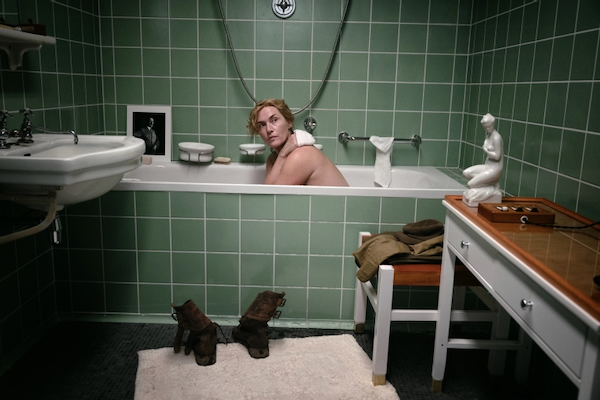Movie review by Greg Carlson
The brilliant cinematographer Ellen Kuras makes her narrative feature directorial debut with the long-gestating biopic “Lee.” Reuniting with Kate Winslet, with whom she worked on “Eternal Sunshine of the Spotless Mind,” Kuras explores the career highlights of model turned World War II photographer Lee Miller, whose images of Buchenwald and Dachau are among the most immediate and gripping concentration camp photos of the historic record. Producer and star Winslet, who labored for the better part of a decade to bring Miller’s story to the screen, works from a screenplay by Liz Hannah, John Collee, and Marion Hume. Their script, adapted from the 1985 book “The Lives of Lee Miller” by Miller’s son Antony Penrose, provides the foundation for a handsomely mounted but unspectacular, underwhelming experience.
Nobody who has admired the career of Winslet will argue that she is anything less than dynamite as the title subject. The consistently potent characterizations of the Academy Award-winner span many genres, and she has been riveting and at home in period costume and contemporary settings alike. In “Lee,” Winslet outshines her capable castmates. The thin sketches of key Miller friends, lovers, and acquaintances are frustratingly underwritten. Of the ensemble members, Andy Samberg’s David Scherman is given the most to do, but the particulars of Miller’s romantic partnership with modern artist and poet Roland Penrose (Alexander Skarsgård) come and go as a matter of convenience.
Fellow Oscar recipient Marion Cotillard, as one-time French “Vogue” editor Solange D’Ayen, is woefully underutilized; with the exception of a short scene dramatizing the horrific personal toll of war’s destruction, she is relegated to a curious status assigned to several other top-notch actors: Noémie Merlant (as Nusch Éluard) and Andrea Riseborough (as Dame Audrey Withers) are two additional people significant to Miller. Katie Walsh has observed that Miller, “seeks out the women in war” in part “ … because she’s often shut out of male spaces … “ And yet, Kuras often elects to underplay the discrimination faced by Miller on the basis of her sex.
Along with the revolving door approach to the supporting cast, “Lee” also struggles to find the breathing room for us to contemplate Miller’s intense understanding of and relationship to the camera. Moving from the front of the lens to behind the viewfinder carries with it any number of complexities (as a teenager, Miller modeled in the nude for her father), but Kuras highlights relentless drive and ambition in favor of curiosity about the photographer’s approach to image manipulation and staging in the liminal space between journalistic documentation and the making of art.
The exception to that question resides in a set-piece recreating one of the best known images of Miller (from several frames composed and staged in collaboration with Scherman): a portrait of the former fashionista bathing in Hitler’s Munich apartment tub on the very day of his suicide, her dirty combat boots muddy on the bath mat. Kuras implies that the scene was hastily stitched together as Miller and Scherman furtively arranged key objects, including a portrait of Hitler, around the tiles. The resulting message, that the German leader’s private lavatory now belonged to a woman and a Jew, suggests that a picture is worth a thousand biopics.
